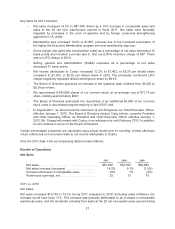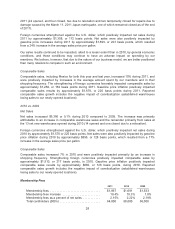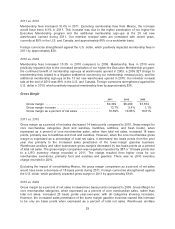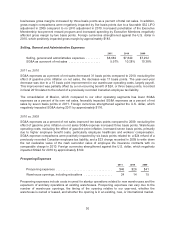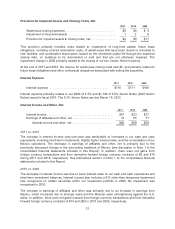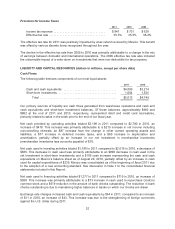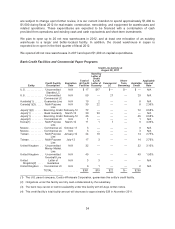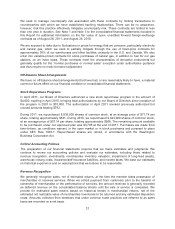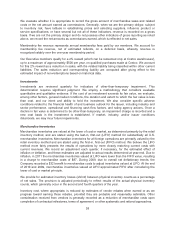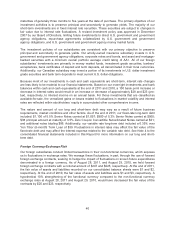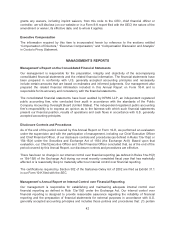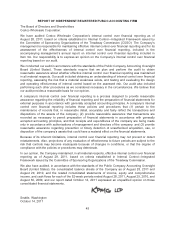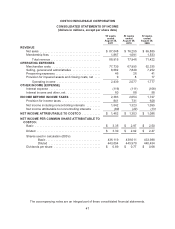Costco 2011 Annual Report Download - page 39
Download and view the complete annual report
Please find page 39 of the 2011 Costco annual report below. You can navigate through the pages in the report by either clicking on the pages listed below, or by using the keyword search tool below to find specific information within the annual report.We seek to manage counterparty risk associated with these contracts by limiting transactions to
counterparties with which we have established banking relationships. There can be no assurance,
however, that this practice effectively mitigates counterparty risk. These contracts are limited to less
than one year in duration. See Note 1 and Note 3 to the consolidated financial statements included in
this Report for additional information on the fair value of open, unsettled forward foreign-exchange
contracts as of August 28, 2011, and August 29, 2010.
We are exposed to risks due to fluctuations in prices for energy that we consume, particularly electricity
and natural gas, which we seek to partially mitigate through the use of fixed-price contracts for
approximately 36% of our warehouses and other facilities, primarily in the U.S. and Canada. We also
enter into variable-priced contracts for some purchases of natural gas, in addition to fuel for our gas
stations, on an index basis. These contracts meet the characteristics of derivative instruments but
generally qualify for the “normal purchases or normal sales” exception under authoritative guidance
and thus require no mark-to-market adjustment.
Off-Balance Sheet Arrangements
We have no off-balance sheet arrangements that have had, or are reasonably likely to have, a material
current or future effect on our financial condition or consolidated financial statements.
Stock Repurchase Programs
In April 2011, our Board of Directors authorized a new stock repurchase program in the amount of
$4,000, expiring in April 2015, bringing total authorizations by our Board of Directors since inception of
the program in 2001 to $10,800. The authorization in April 2011 revoked previously authorized but
unused amounts totaling $792.
During 2011, we repurchased 8,939,000 shares of common stock, at an average price of $71.74 per
share, totaling approximately $641. During 2010, we repurchased 9,943,000 shares of common stock,
at an average price of $57.14 per share, totaling approximately $568. The remaining amount available
to be purchased under our approved plan was $3,706 at the end of 2011. Purchases are made from
time-to-time, as conditions warrant, in the open market or in block purchases and pursuant to plans
under SEC Rule 10b5-1. Repurchased shares are retired, in accordance with the Washington
Business Corporation Act.
Critical Accounting Policies
The preparation of our financial statements requires that we make estimates and judgments. We
continue to review our accounting policies and evaluate our estimates, including those related to
revenue recognition, investments, merchandise inventory valuation, impairment of long-lived assets,
warehouse closing costs, insurance/self-insurance liabilities, and income taxes. We base our estimates
on historical experience and on assumptions that we believe to be reasonable.
Revenue Recognition
We generally recognize sales, net of estimated returns, at the time the member takes possession of
merchandise or receives services. When we collect payment from customers prior to the transfer of
ownership of merchandise or the performance of services, the amount received is generally recorded
as deferred revenue on the consolidated balance sheets until the sale or service is completed. We
provide for estimated sales returns based on historical trends in merchandise returns, net of the
estimated net realizable value of merchandise inventories to be returned and any estimated disposition
costs. Amounts collected from members that under common trade practices are referred to as sales
taxes are recorded on a net basis.
37


